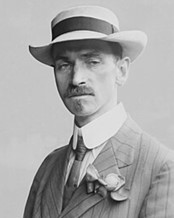Rationale for Inclusion
- Early Pioneer in Aviation and Motorcycles: Glenn Curtiss was already a well-known motorcycle manufacturer and racer before he entered aviation. Known as the “Fastest Man on Earth,” he set a land speed record of 136 mph in 1907 on one of his motorcycles, showcasing his engineering skill and passion for speed. His expertise in lightweight, high-performance engines would later prove invaluable in aviation, where he quickly became a leading innovator.
- Key Figure in Early Aircraft Design and Manufacturing: Curtiss designed and manufactured some of the first practical airplanes in the United States, including the Curtiss Model D, one of the earliest mass-produced aircraft. He introduced innovations like ailerons, which provided greater control and stability in flight. Curtiss’s use of ailerons eventually became a standard feature in aircraft design, replacing the wing-warping method.
- Pioneer of Naval Aviation and the Flying Boat: Glenn Curtiss is often considered the father of naval aviation due to his groundbreaking work with flying boats and seaplanes. His Curtiss Model E Flying Boat in 1912 was the first successful seaplane in the U.S., and he went on to design flying boats that became essential for both military and commercial use.
- Significant Legal and Business Rivalry with the Wright Brothers: Curtiss’s work led to a historic and intense rivalry with the Wright brothers over patent rights, specifically concerning aircraft control mechanisms. While the legal battle was contentious, it also spurred innovation and led to the eventual formation of a patent pool that allowed for shared access to patents and accelerated the growth of aviation technology in the United States.
- Founder of the Curtiss Aeroplane and Motor Company: In 1916, Curtiss established the Curtiss Aeroplane and Motor Company, which became one of the largest and most successful aircraft manufacturers during World War I. The company produced thousands of aircraft for the Allied forces, including the Curtiss JN-4 “Jenny”, which was widely used for training American and Allied pilots. After the war, the “Jenny” became the primary aircraft for barnstormers, helping to popularize aviation in the United States.
- Advancements in Engine Design and Performance: Curtiss’s engines were instrumental in early aviation, as he developed some of the most powerful and reliable engines of his time. His engines powered several important aircraft, including the Curtiss V-8 engine, which was used by Alexander Graham Bell’s Aerial Experiment Association (AEA) to achieve early flight successes.
- Historic Contributions to Long-Distance and Record-Setting Flights: Curtiss played a key role in advancing the feasibility of long-distance flight. In 1910, he completed a historic flight from Albany to New York City, becoming the first person to fly over 150 miles in one continuous flight and winning the Scientific American Trophy. This flight proved the viability of long-distance air travel and earned Curtiss significant public acclaim.

Biography
- Early Life and Education: Glenn Hammond Curtiss was born on May 21, 1878, in Hammondsport, New York. Curtiss developed an early interest in mechanics and speed, working as a bicycle repairman and racer before transitioning to motorcycles. In 1902, he founded the Curtiss Motorcycle Company.
- Personal Life: Glenn Curtiss was known for his adventurous spirit and passion for innovation, constantly exploring new technologies and pushing boundaries. He was married to Lena Neff, and together they had two children. Curtiss maintained a relatively private family life, focusing much of his energy on his work.
- Early Career: Curtiss’s aviation career began in 1904 when he provided engines for the Aerial Experiment Association (AEA), a research group founded by Alexander Graham Bell. His first solo flight in 1908 in the AEA June Bug marked a significant achievement, and in 1909, he won the Scientific American Trophy for completing the first publicly witnessed flight of over one kilometer in the United States.
- In recognition of his service to aviation Curtiss received numerous awards and accolades, including:
- Induction into the International Air & Space Hall of Fame (1965)
- Induction into the National Aviation Hall of Fame (1964)
- National Inventors Hall of Fame (2003)
- Awarded the Distinguished Flying Cross (1933)
